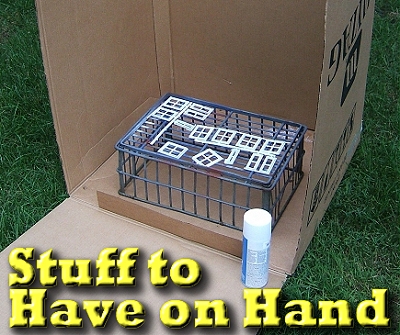Stuff to Have on Hand
One of the fun parts of Garden Railroading is building your own communities and industries for your railroad to serve. Fortunately many resources are available, including kits, building supplies, and things you can scrounge to use on your buildings.
If your life is like mine, however, you only have a limited time to work on your hobbies, so you need to be able to make the best use of the time you have once you get started on a project. The last thing you need is to get into the middle of what ought to be a 1-hour project, then realize you need to make a trip to the store for something else you didn't realize you needed. One way to avoid that is to pick up a few dollars' worth of supplies to keep on hand, and to start collecting other things you'll need sooner or later when you come across them. In fact keeping those supplies together in one place wouldn't hurt either. So, the next time you see those clear plastic bins on sale (the 48-quart or larger ones), pick up one (or twenty, if you need to clean out your workshop or attic), and start collecting things you know you'll need sooner or later. This way, if you get a few minutes to fiddle with a new building kit, you'll be able to make some progress in the time you have, instead of opening the box and then remembering that you forgot to pick up something you needed.
Stuff You Will Need or Find Useful Anyway So You Should Probably Pick It Up Soon - The following list describes stuff you should keep on hand so you don't have to make a run to the store every time you have a chance to spend twenty minutes on some structure project.
- Masking Tape, in several widths
- Spray Paint - Spray paint, when used properly, can provide a fine coating that neither obscures details nor shows brush-strokes. For Gray Primer, Rust (Red) Primer, Flat White, and Flat Black, the $1 house-brand they sell at places like Wal-Mart are just as useful as the expensive brands. The next time you go to Big Lots or someplace that sells $1 primer, etc., get one or two of each of the following products. Then replace them as you use them up. You should have one or two $1 cans of each of these in your shop at all times.
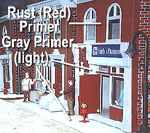 Gray Primer - Useful for undercoat, especially on structures that will be painted with a lighter topcoat. Also useful for many "industrial" details, such as ladders, railings, pipes, etc. If you can come up with a light gray that works for concrete, you've really got something. Of course, there's no quality control on the colors, so you never know exactly what shade the next can will contain. You should have one or two $1 cans of this in your shop at all times. Gray Primer - Useful for undercoat, especially on structures that will be painted with a lighter topcoat. Also useful for many "industrial" details, such as ladders, railings, pipes, etc. If you can come up with a light gray that works for concrete, you've really got something. Of course, there's no quality control on the colors, so you never know exactly what shade the next can will contain. You should have one or two $1 cans of this in your shop at all times.
- Rust (Red) Primer - Iron oxide is the cheapest pigment in the world, which is one reason that so many barns, covered bridges, and boxcars are painted with rust-colored paint. (Hobby shops talk about "boxcar red," "tuscan red," and so on, but they're all versions of "rust color," so go with cheap paint the way the big boys do.) Useful for undercoats on structures which will be painted darker, and for topcoats on structures that will be painted rust-color.
- Flat Black - Covers better and looks better on most surfaces than shiny black. Useful, not only as a topcoat, but for some kinds of weathering. You should have one or two $1 cans of this in your shop at all times.
- Flat White - Covers much better and looks much better on most surfaces than shiny white. You should have one or two $1 cans of this in your shop at all times.
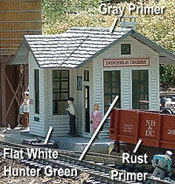 White Primer (Optional) - If you can come up with this for less than $4 a can, white primer is very useful for priming products that will later be painted white or a very light color. Most white primers suck as topcoats, though. Flat white is the topcoat of choice for white structures. White Primer (Optional) - If you can come up with this for less than $4 a can, white primer is very useful for priming products that will later be painted white or a very light color. Most white primers suck as topcoats, though. Flat white is the topcoat of choice for white structures.
- Cheap Hobby Paintbrushes - Get the kind that come ten for a dollar at the Dollar store. If you're into expensive camels-hair brushes or the like, try to use them only when you're doing very fine work (such as painting signs). For everything else, the cheapo brushes will do just as well, and when you ruin one you don't feel bad about throwing it away. This also saves you the nuisance and danger of having to leave a can of turpentine or paint thinner around. (Yes, I was raised to feel guilty if I didn't stink up the house using $2 worth of paint thinner trying to "save" a $2 paintbrush that was overkill for the project I was using it for anyway. If you were, too, get over it.)
- Glue - Some people use one all-purpose weatherproof glue such as the water-resistant Liquid Nails product. I prefer to have at least a couple on hand (model cement, by the way, is not usually the best choice for garden railway structures, so it's not on my list):
- Superglue - By whatever name you choose, a cyanoacrylate adhesive will let you pop the pieces of a structure together in a few minutes, so that you don't have to clamp the thing and leave it overnight to dry one or more times during the assembly process as you would with slow-drying glues. That said, I usually go back and use another product to reinforce the joints after everything else is done. A structure that is held together only by superglue is likely to pop apart if pressure is put on it the wrong way. By the way, it's no mistake that cyanoacrylate is usually sold in three-for-a-dollar blister packs or some such. Even if you take great care in resealing a tube, it's not unusual to get one real gluing session out of a cyanoacrylate tube before the cyanoacrylate sets up in the nozzle and makes the rest of the tube's contents unusable. So get the three-pack. Or get two three-packs. (And if you really want to impress people with your expertise, learn to say sye-uh-noh-AH-kruh-late.)
- Something Else - In addition to the Superglue, get something that you can use to reinforce important joints once the structure is superglued together. Some folks use a clear silicone (although it gives out eventually in very warm climates). Some use a waterproof version of Liquid Nails. I like Duco household cement, although I'm often experimenting. At any rate, the cyanoacrylate is just to hold the thing together on gluing day. When you're sure you have it together the way you want it, goop up the wall and roof joints with silicone or whatever to make the structure less likely to come apart when you're moving it around.
Stuff to Collect for Use Later -
This list includes stuff you should hang onto when you come across it.
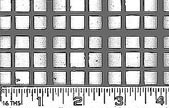 - Plant and Vegetable Trays - The things that you bring home strawberries or seedling in often have a "hash" pattern that can be used for window mullions when you are building your own buildings or dressing up buildings you got from other sources. Of course the "mullions" will need to be painted (most of the plastic isn't UV-resistant), and you should probably put Lucite or something behind them to reduce the risk of someone punching through one by accident when moving the building. But making "windows" this way is fast, attractive, and cheap. (For more ideas about mullions, click here.
- Lucite and Plexiglass - Never pass up Lucite or Plexiglass if you can come by it free. These sturdy, weather-resistant materials can be used in many ways when you are building structures.
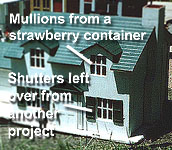 - Thin, Clear Stock for Window Panes - One of the most common uses of Lucite is in thin (1/8" or so) panes for use in storm windows or replacement panes. This stuff is ideal for using inside buildings to represent glass. Reasons why to keep it onhand and use it in all your structures:
- It is easy to work with once you learn how.
- The glare from the pane makes your buildings look more realistic while making it less obvious that there's nothing inside.
- Having panes behind the mullions decreases the chance that someone will actually put a thumb through the mullions while moving the buildings.
- Having panes in your windows reduces the likelihood of paper wasps or hornets taking over your buildings in the summer.
- Heavier Stock for Structural Use - Heavier grades of Plexiglass and similar material are expensive to buy but possible to scrounge. A friend in Ohio picked some up when his office threw out several Plexiglass "carpet protectors" that had gotten scratched up. I scrounged some material when a local gas station changed hands and had to replace the plexiglass panels on their pumps. You may live near a sign shop that disposes of old plexiglass signs for people, or have some source that's even stranger. That said, there are many uses for this stuff.
- My friend who scrounged the carpet protectors sawed them up into "walls," "bases," and "roofs," then used Precision Products materials to build structures that are pretty much impervious to weather. If you use Precision Products' "Crystal Clear" products, there's no reason you can't build a building around a clear Plexiglass core, then paint everything but the windows.
- Most structure kits sold for Large Scale don't have bases. Stations, especially, would benefit from being glued to "platforms" so you can permanently glue down those accessories you're used to setting out and putting back into place after storms and raccoon attacks. Structural Plexiglass will stand up to just about anything, and if you pick it up whenever a piece comes your way free, you'll think of a thousand uses for it. (I'm using some to replace the masonite and chipboard parts of some Fischer Price buildings I trashbashed some years ago still like to use on my railroad.)
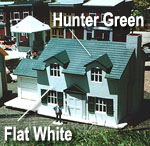 Stuff You'll Accumulate on an As-Needed Basis -
This list includes products you will pick up on a project-by-project basis but which are worth keeping onhand once you have them. Stuff You'll Accumulate on an As-Needed Basis -
This list includes products you will pick up on a project-by-project basis but which are worth keeping onhand once you have them.
- Other Flat or Satin Outdoor Finishes - You'll probably accumulate these on an as-needed basis. For example, I often use a $3 "Hunter Green" in an outdoor satin finish. Experiment to find a brand you like - two similarly priced Hunter Green paints from two different companies had entirely different results as far as how well they covered, how easily the paint scraped off, and so on. Again, flat covers better than satin, and satin covers much better and looks much more realistic on structures than glossy.
- Acrylic Paint
    Acrylic Craft Paint - If you need any special colors in small quantities, you'll probably start collecting a few of these. They clean up with water, but they'll do fine outside if you spray them with a light coat of matte or satin UV-resistant finish. Acrylic Craft Paint - If you need any special colors in small quantities, you'll probably start collecting a few of these. They clean up with water, but they'll do fine outside if you spray them with a light coat of matte or satin UV-resistant finish.
- Acrylic House Paint - House paint tends to go on in layers that are thick enough to obscure detail. That said, I have a big can of acrylic white housepaint that I use when I need to touch up a white structure that has been banged up. And it is UV- and weather-resistant, after all. If you have some acrylic housepaint left over from a project, dump it into an airtight plastic container like a sour cream container - otherwise the can it came in will rust eventually. Latex house paint, by the way, may be useful for wooden structures, on which it can soak into the wood, but it doesn't adhere to plastic well.
- Leftover Parts - Many kits have a few extra parts, especially things like extra window frames or shutters that you'll be able to use to dress up other projects. Keep them together in a "spare parts box" so you know where they are when you need them.
Return to the Garden Railroad Structures page 
|


|

